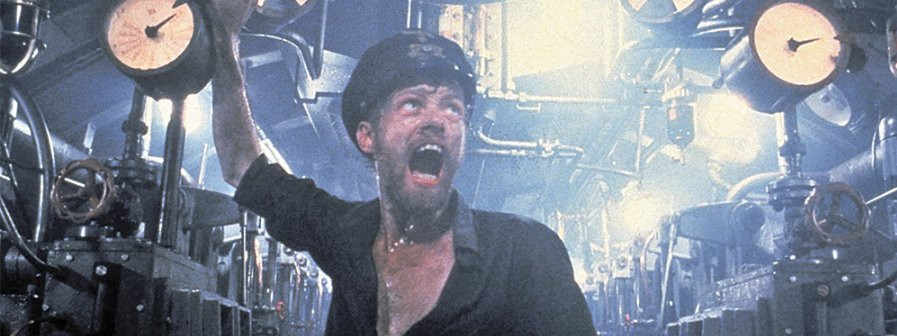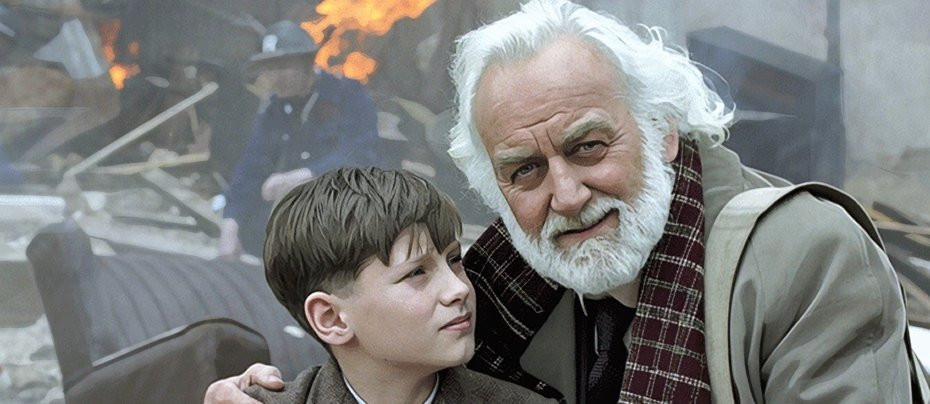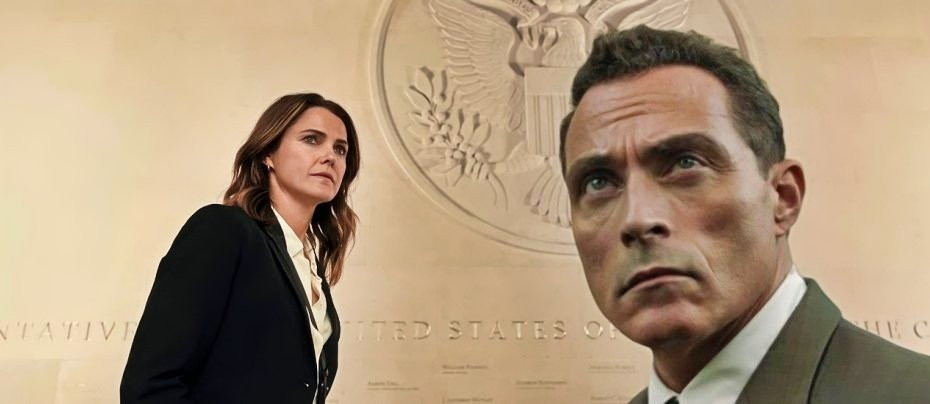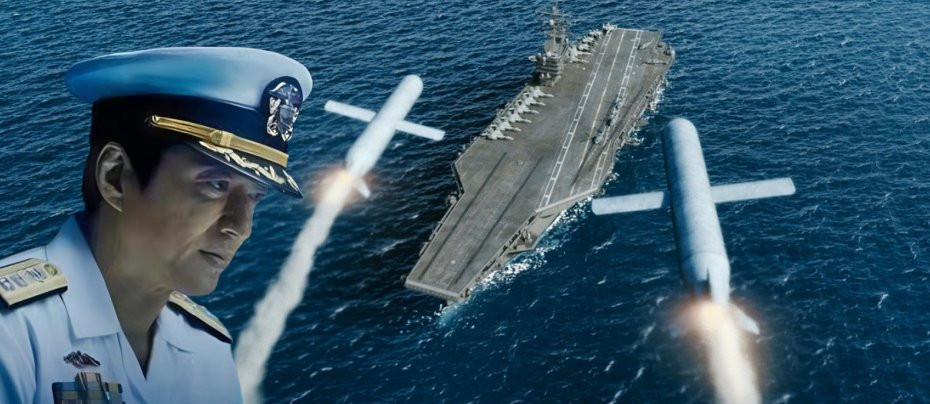
The Silent Service
2023 - JapanThe plot is straight out of Tom Clancy's ‘The Hunt for Red October’
Review by John Winterson Richards
The submarine film has become a well-established subgenre of the war film in its own right. In contrast with the traditional war epic, the submarine film emphasises the experience of a small, tight knit group of highly trained specialists in a very confined space surrounded by a totally hostile environment and dependent for their survival on their mastery of advanced technology. As such, it has much in common with "hard" science fiction set in Outer Space, and the most credible battles in the likes of Star Trek are often reminiscent of submarine duels, with opposing commanders playing a form of high stakes chess with each other.
The relative lack of noise and movement means the submarine subgenre is more cinematic than televisual, despite such honourable small screen forays as Voyage to the Bottom of the Sea, SeaQuest DSV, and the television version of Das Boot. To be appreciated fully, the subtleties of a submarine battle demand that the viewer focus completely on the screen, so it helps if the screen is a big one and there are no distractions. This is why television has not made more use of the potential advantages of pure submarine drama, which one might think would appeal to producers with limited budgets because it should in theory require few sets and a relatively small cast. In practice, however, submarine drama, on both film and television, has usually extended beyond the purely submarine to include surface sequences as well.
This is the case with Amazon's recent acquisition from Japan, The Silent Service. It might have been better if it had stuck to the submarine, because, while its best underwater sequences bear comparison with the classic films of the subgenre, it loses all credibility when it blows its tanks and surfaces.
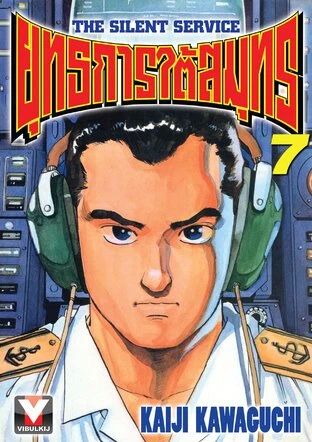
Like so many television projects these days, The Silent Service started life as a comicbook, an award winning manga that ran between 1988 and 1996. As usual an anime adaptation and then a video game soon followed. More of a surprise was how it suddenly resurfaced last year as a live action feature film that had a cinematic release in Japan. Following the precedent set by Das Boot, an eight part version has now appeared, its alternative title, The Silent Service: the Battle of Tokyo Bay, and its ending suggesting aspirations to be an ongoing series.
The plot is straight out of Tom Clancy's The Hunt for Red October, with hints of Jules Verne's Nemo and Robur novels. The experienced Captain of a nuclear-powered submarine appears to have gone rogue. Whether he is also in possession of nuclear weapons is the big question.
Most Western viewers will probably not appreciate the full significance of this without a bit of background knowledge. Japan is very much aware of its status as the only nation in the world to have been hit by nuclear weapons - a point made several times in The Silent Service. The reasons for that happening are never mentioned.
Following Japan's consequent surrender in 1945, the victorious American General Douglas MacArthur presented the Japanese with a new Constitution written by his staff. Its Article 9 renounces war as an instrument of State policy - rather ignoring the fact that the use or threat of force is the defining feature of a State that distinguishes it from all other forms of social organisation. The Japanese Diet itself, apparently on its own initiative in a sincere but temporary pacifist mood, added a sub-clause prohibiting the establishment of Armed Forces.
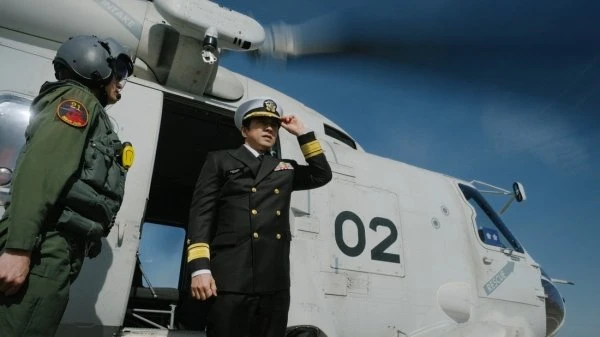
Although Article 9 remains in force, unamended, to this day, it soon became a dead letter. The fall of China to Mao's Communists three years later changed American policy very quickly and the Americans not only approved but encouraged Japanese rearmament. Japan now has among the largest and most powerful Armed Forces in the world, except, in polite deference to Article 9, it does not call them Armed Forces. They are officially "Self Defence Forces." The Constitution is "interpreted" so that this is sufficient to get around Article 9 as still stands.
The naval component of the Armed Forces, officially the "Maritime Self Defence Forces," is the fourth largest navy in the world by tonnage. At the time of writing, it has more serving personnel than the United Kingdom's Royal Navy. Japan is therefore a major naval power once again, even if it is still, like everyone else, dwarfed by the might of the United States Navy.
Despite its restored military tradition, Japan, for obvious historical reasons, remains very sensitive about the possession of nuclear weapons. Although committed to the principles of non-proliferation, Japan has the technology to put them together very quickly and everyone knows it.

So all sorts of issues are raised when Shiro Kaiedo absconds with a new submarine that is considerably superior to standard submarines, especially since he is, for diplomatic reasons associated with that Japanese sensibility about all things nuclear, seconded at the time to the US Navy, with the rank of Rear Admiral, and the submarine is sailing, if that is the right expression for submarines, under the US Flag.
This is actually a clever set up for what might have been an intelligent political thriller. A mention of Leviathan hints at reference to Thomas Hobbes' classic political essay on what he saw as the need for an all-powerful government to restrain human violence. The manga was a product of the time at the end of the Cold War when the United States was just such an all-powerful government on the global stage. A dramatised discussion of the issues under the somewhat different circumstances of 2023 might be interesting, so it is regrettable that The Silent Service chooses not to go this way and things soon start to get a bit silly.
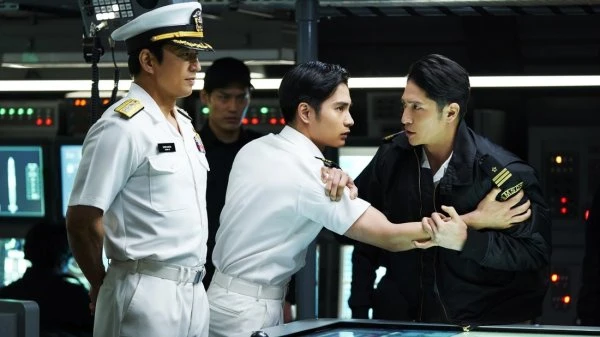
Indeed this is doubly a pity because it rather wastes a strong protagonist who could have been explored in greater depth in a more character driven piece. "Command presence" is an elusive concept but, whatever it is, there is no denying that Kaiedo, as played by Takao Osawa, has it by the bucket. Apparently in complete control of himself, his submarine, and the situation even in the most stressful circumstances, he stands immovable on his command deck in the formal "At Ease" position - which is actually not very comfortable - in his perfectly cleaned and pressed white uniform, the epitome of calm amid chaos. No wonder his crew have complete confidence in him, especially since they know their Mozart-loving commander has already worked out the pattern of events and they are simply playing out a symphony he has written in advance.
He is a great character who deserves better plotting. The rest of the characters are a bit cartoonish, even if it should be acknowledged that the Japanese members of the cast at least play their poorly written roles well.
Before addressing the negative aspects of The Silent Service, credit should also be given to the direction of the underwater action scenes. Most of the computer-generated imagery (CGI) is of acceptable quality. As The Last Ship demonstrated, some years ago now, it is relatively easy to get CGI seascapes right, and technology and techniques have improved considerably since then. Indeed, the problem is that video game players in particular have become used to such a high standard that lapses are more noticeable. There are a couple of misjudged shots or sequences in The Silent Service where one is very much reminded that this is CGI, but on the whole the action scenes are both exciting and immersive.

The worst thing about The Silent Service, but also the main reason why it demands discussion, is its shocking anti-Americanism. Except for one token sensible Admiral, practically all the American characters, from the President down to the commanders of individual US submarines, are portrayed as pantomime villains. They snarl, they threaten, and they speak in menacing tones all the time. Their motivation is presented as irrationally evil, because... because... er... well, it seems because they are American. Is this how Japanese people, at least the Japanese people involved in making The Silent Service, actually see Americans, the only protection standing between them and the increasingly belligerent Chinese Communists? Like Japan's role in World War Two, China is never mentioned once in The Silent Service.
The writers and producers, who include Osawa, apparently still have a gigantic chip on their shoulder about what happened in 1945, one that blinds them to obvious facts that might challenge their world view. Old style Japanese militarism is given a very thin pretext of anti-nuclear pacifism. It is especially frightening to read that the original manga is said to have been very popular with the "Self Defence Forces."
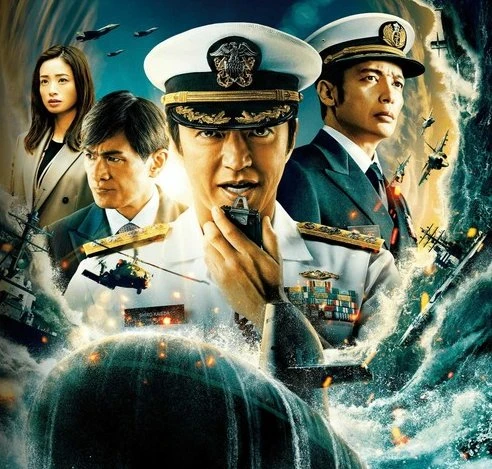
Perhaps more insulting to their American allies is how they are portrayed as total idiots. Our single Japanese submarine bests multiple American opponents with ease and takes on full Carrier Battle Groups on its own. In reality, such a Battle Group would be spread over hundreds of square miles precisely to prevent what happens in The Silent Service. Aircraft carriers do not try to ram submarines. They do not have to. That is why they have aircraft.
Indeed, all the characters make unrealistic decisions that people in their positions would almost certainly never even consider in real life - not only the American politicians and Admirals but their Japanese equivalents, and another Japanese submarine commander who was once Kaiedo's second-in-command and now has trouble deciding whose side he is on. Would such a character pass the psychological screening necessary for such a responsible post? The same question might be asked of practically all the other characters, including even Kaiedo himself, and there comes a point when it spoils what might otherwise be a very compelling action show.
Seen this show? How do you rate it?
Seen this show? How do you rate it?
Published on March 14th, 2024. Written by John Winterson Richards for Television Heaven.



